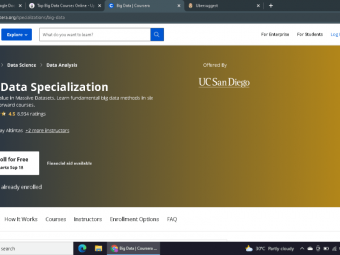1z0 071 Learn Oracle Sql Database Using Developer
The SELECT statement, functions and more. Oracle Database 11g, 12c, 19c, 21c using Oracle SQL Developer. 1Z0-071 exam.
Last updated 2022-01-10 | 4.6
- Create tables in a database and ALTER columns in the table.- Know what data type to use in various situations
- and use functions to manipulate date
- number and string data values.
- Retrieve data using SELECT
- FROM
- WHERE
- GROUP BY
- HAVING and ORDER BY.
What you'll learn
* Requirements
* You need to know how to use a computer* and hopefully know how to use a spreadsheet.
* No prior knowledge of Oracle SQL Database or any other database required - although the more knowledge you do have
* the better.
* To install Oracle SQL Database on your computer
* you will need a 64-bit machine.
* Oracle SQL Database cannot easily be installed on the Mac OS. If you wish to install it on a Mac
* you will need either to dual boot into Windows or be running Parallel Desktop.
* You don't even need Oracle SQL Database installed - I'll show you have to install it on your computer for free!
* There is a 30-day money back guarantee of this Udemy course.
* Why not have a look at the curriculum below and see what you can learn?
Description
This course is the foundation for the Oracle Database SQL 1Z0-071 certification. It covers the SELECT statement in detail, with additional requirements for controlling user access. It is divided into 6 sessions, each of which should take a morning or afternoon to complete.
What do people like you say about this course?
Prashant says: "Course has been designed in way that a person with no knowledge of Oracle can understand it. Good learning and thanks a lot for making such nice course."
Shubho says: "Awesome course. The instructor explains the concepts very thorougly and in a easy-to-grasp way. Also, the practice exercises are super helpful. If you want to master Oracle SQL, this is the course for you."
Henry says: "I want to thank Phillip for this formidable course. This course along with other materials helped me to pass the 1Z0-071 Exam last Saturday."
Session 1
We'll install for free Oracle Express Edition and Oracle SQL Developer. Then we'll take a look at the 6 principal clauses of the SELECT statement: SELECT, FROM, WHERE, GROUP BY, HAVING and ORDER BY.
Then we'll start creating tables, but find that we can't get very far without understanding data types. We'll then look at string, date and number types and functions, together with looking at functions converting between them.
Session 2
We'll revisit the SELECT statement and go into more detail. We'll create tables and JOIN them together. Once you have finished this session, you should be secure in your knowledge of the 6 principal clauses of the SELECT statement, the most important part of Oracle SQL.
Session 3
In session 3, we'll looking for missing data, and find out how to delete and update data. We'll look at the difference between implicit and explicit transactions, and various constraints, including primary and foreign keys.
Session 4
We'll start off by saving our queries in views. Then we'll combine tables, not by adding additional columns using JOINS, but adding additional rows such Oracle SQL set operators such as UNION, INTERSECT and MERGE. Then we'll look at analytical functions using the OVER clause.
Session 5
Session 5 starts off by adding totals to our SELECT queries. We'll then look at subqueries, and how you can add them into the FROM, SELECT and WHERE clauses, and also into the WITH clause. Finally, we'll look at Oracle SQL self-joins, which are useful when you have hierarchies.
Session 6
Session 6 starts off with two additional data types, TIME ZONE and INTERVAL data types and functions. We'll then have a look at SEQUENCEs and INDEXes, together with how these are shown in the Data Dictionary. We'll then create new users, and assign privileges and roles to them, and we'll finish with the last few requirements for the exam.
No prior knowledge is required - we'll even install Oracle Database and Oracle SQL Developer on your computer for free!
Once finished, you will know what how to manipulate numbers, strings and dates, and create database and tables, create tables, insert data and create analyses, and have an appreciation of how they can all be used in Oracle SQL.
Who this course is for:
- This SQL course is meant for you, if you have not used Oracle SQL Database much (or at all), and want to learn SQL.
- This course is also for you if you want a refresher on SQL. However, no prior Oracle SQL Database knowledge is required.
Course content
37 sections • 215 lectures
Introduction Preview 02:04
Welcome to Udemy Preview 00:35
The Udemy Interface Preview 02:00
Do you want auto-translated subtitles in more languages? Preview 01:10
Resources Preview 00:05
Curriculum Preview 06:45
Download and Install Oracle Express Edition Preview 06:05
Download and Install Oracle SQL Developer Preview 04:31
Connect to Database Preview 03:37
Solving "The network adaptor cannot establish the connection" error Preview 02:37
8e. The SELECT and FROM clauses Preview 08:59
Renaming fields Preview 06:30
Using the AS keyword Preview 02:18
Semicolons and comments Preview 04:55
3b, 13b. The WHERE clause Preview 05:56
15b. The GROUP BY clause Preview 07:19
15c. The HAVING clause, and information about error messages. Preview 05:29
13a, 13c. The ORDER BY clause Preview 04:12
Remembering the order of the clauses Preview 02:28
Practice Activity Number 1 Preview 00:22
Practice Activity Number 1 - The Solution Preview 04:56
Creating a table using the GUI Preview 03:04
Creating our first table using SQL Preview 02:36
17a. Inserting values Preview 02:04
Deleting the data, then the table Preview 02:52
Trying to create an Employee table Preview 03:45
Using the DUAL table Preview 03:53
Practice Activity Number 2 - Writing mathematical queries Preview 00:19
Now it's your turn.
This exercise is to practice writing a query, and creating simple mathematical expressions.
Practice Activity Number 2 - The Solution Preview 02:34
8c. Creating sample table; Run Script v Run Statement Preview 06:45
8a. The NUMBER data type Preview 08:35
Do you want to use the comma as a decimal point? Preview 04:25
8a. FLOATing data types Preview 04:54
Practice Activity Number 3 Preview 00:18
Practice Activity Number 3 - The Solution Preview 04:26
5b, 14a. Numeric functions Part 1 Preview 06:13
Rounding functions Preview 08:18
Practice Activity Number 4 Preview 00:27
Practice Activity Number 4 - The Solution Preview 03:26
Character Encoding Systems Preview 04:14
8a. Character Data Types Preview 11:04
5b, 14a. String Functions Preview 07:12
NULL - an introduction Preview 05:52
Useful NULL functions Preview 07:20
NVL, NVL2, NULLIF and COALESCE
Adding quotation marks and Alternative Quoting Mechanism in string literals Preview 04:15
Practice Activity Number 5 Preview 00:42
Practice Activity Number 5 - The Solution Preview 05:26
5b, 14a. Joining a string to a number using implicit conversions Preview 04:18
5a, 14b. Converting a number to a string Preview 09:46
5a, 14b. Converting a string to a number, including the CAST function Preview 04:58
5a, 14b. International conversions Preview 06:55
Practice Activity Number 6 Preview 00:14
Practice Activity Number 6 - The Solution Preview 03:22
8a. DATE and TIMESTAMP() data types Preview 07:45
5b, 14a. Date extraction functions Preview 07:43
5a, 14b. Converting dates to strings Preview 12:12
5a, 14b. Converting times to strings Preview 06:17
5a, 14b. Converting strings to timestamps, and international considerations Preview 09:30
Practice Activity Number 7 Preview 00:47
Practice Activity Number 7 - The Solution Preview 06:13
End of Session 1 Preview 02:41
Welcome to Session 2 Preview 01:33
Creation of tblEmployee table Preview 11:12
Adding and modifying additional columns Preview 07:14
3b, 13b. SELECTing only part of a table - strings Preview 10:46
3b, 13b. SELECTing only part of a table - numbers Preview 08:35
3b, 13b. SELECTing only part of a table - dates Preview 06:07
Practice Activity Number 8 - Creating Tables Preview 00:17
Practice Activity Number 8 - The Solution Preview 09:16
Populating the Practice Activity tables Preview 00:02
Practice Activity Number 9 Preview 00:16
Practice Activity Number 9 - The Solution Preview 03:04
13c, 15b. Summarising and ordering data Preview 06:45
15c. Criteria on summarised data Preview 11:34
Exercise - Part 1 Preview 07:58
13a, 13c. Exercise - Part 2, and ORDER BY NULLS FIRST/LAST Preview 08:25
Practice Activity Number 10 Preview 00:15
Practice Activity Number 10 - The Solution Preview 05:03
Adding a second table Preview 04:23
Designing a connection Preview 10:32
12a. Importing data and showing tables graphically Preview 05:39
Writing a JOIN query Preview 09:33
4a. Different types of JOIN Preview 12:59
4b. Using NATURAL JOINs Preview 05:37
4b. Old notation joins Preview 03:03
Practice Activity Number 11 Preview 00:30
Practice Activity Number 11 - The Solution Preview 09:43
Creating a third table Preview 08:30
6a, 6c. JOINing three tables Preview 09:26
Practice Activity Number 12 Preview 00:28
Practice Activity Number 12 - The Solution Preview 11:38
End of Session 2 Preview 01:17
Welcome to Session 3 Preview 02:11
2b. Missing data Preview 10:31
2b. Deleting data Preview 07:59
2b. Updating data Preview 04:46
Practice Activity Number 13 Preview 00:31
Practice Activity Number 13 - The Solution Preview 08:52
1a, 11c. The relationship of a database and SQL Preview 05:10
1a. Explain the relationship between a database and SQL.
11c. Explain the theoretical and physical aspects of a relational database.
2a, 2b, 11a, 11b. DML, DDL, DCL and TCL Preview 06:19
17d. What are transactions? Preview 04:50
17d. Implicit transactions Preview 05:10
2c, Explicit Transactions - Start and end transactions Preview 07:07
Include V$TRANSACTION
2c, Savepoints and roolback to savepoints Preview 07:03
SCN = system change number.
Formatting in Oracle SQL Developer Preview 03:51
Problems with our existing database Preview 06:41
What are constraints? Preview 05:53
Unique constraints - what are they? Preview 02:21
Unique constraints in action Preview 11:56
Default constraints - what are they? Preview 02:44
Default constraints in action Preview 07:11
Check constraint - what are they? Preview 02:45
Check constraints - in practice Preview 10:02
Primary key Preview 04:57
Primary key - in practice Preview 10:28
Foreign key - what is it? Preview 07:13
Foreign key - in practice Preview 09:59
12a. How are constraints shown in ERDs? Preview 03:29
Practice Activity Number 14 Preview 00:17
Practice Activity Number 14 - The Solution Preview 10:57
Well done for getting half way through the course Preview 00:40
Welcome to Session 4 Preview 01:06
Creating views Preview 04:25
Altering and dropping views Preview 03:43
Adding new rows to views Preview 10:44
Hiding/Unhiding Columns In Views Preview 05:00
Practice Activity Number 15 Preview 00:16
Practice Activity Number 15 - The Solution Preview 05:15
7a. UNION and UNION ALL Preview 09:01
7a. INTERSECT and MINUS Preview 09:50
13d. Use ampersand substitution to restrict and sort output as runtime Preview 08:39
CASE statement Preview 09:30
NVL, NVL2 and Coalesce Preview 08:25
Practice Activity Number 16 Preview 00:46
Practice Activity Number 16 - The Solution Preview 09:23
20b. MERGE statement - in theory Preview 04:56
20b. Let's Build our MERGE statement Preview 06:38
20b. Let's expand our MERGE statement Preview 07:00
20b. Merge with additional columns Preview 06:06
Practice Activity Number 17 Preview 00:23
Practice Activity Number 17 - The Solution Preview 05:34
Introduction Preview 05:03
OVER() Preview 06:25
PARTITION BY and ORDER BY Preview 07:16
RANGE Preview 02:32
CURRENT ROW and UNBOUNDED Preview 03:45
RANGE versus ROWS Preview 07:09
Omitting RANGE/ROW? Preview 06:55
Practice Activity Number 18 Preview 00:19
Practice Activity Number 18 - The Solution Preview 07:37
ROW_NUMBER, RANK and DENSE_RANK Preview 08:04
NTILE Preview 04:58
FIRST_VALUE and LAST_VALUE Preview 06:49
LAG and LEAD Preview 04:44
CUME_DIST and PERCENT_RANK Preview 07:32
PERCENTILE_CONT and PERCENTILE_DISC Preview 06:43
Other Aggregation functions Preview 03:26
Practice Activity Number 19 Preview 00:22
Practice Activity Number 19 - The Solution Preview 05:48
You are two-thirds of the way through the course Preview 00:45
Start of Session 5 Preview 00:42
Adding Totals Preview 06:13
ROLLUP, GROUPING and GROUPING_ID Preview 04:19
GROUPING SETS Preview 05:40
Practice Activity Number 20 Preview 00:18
Practice Activity Number 20 - The Solution Preview 03:17
The WHERE clause Preview 05:05
WHERE and NOT Preview 03:49
ANY, SOME and ALL Preview 06:19
The FROM clause Preview 08:14
The SELECT clause Preview 09:16
16d. Correlated subquery - WHERE EXISTS Preview 08:33
Practice Activity Number 21 Preview 00:23
Practice Activity Number 21 - The Solution Preview 08:28
Top 5 from various categories Preview 05:51
WITH statement Preview 05:37
Generating a list of numbers Preview 11:19
Grouping numbers Preview 09:20
Selecting the third row using rownum and OFFSET and FETCH Preview 08:48
DELETE FROM tbl_employee
WHERE employee_number = 131 and ROWNUM = 2;
does not work - let's find an alternative.








 This course includes:
This course includes:
















